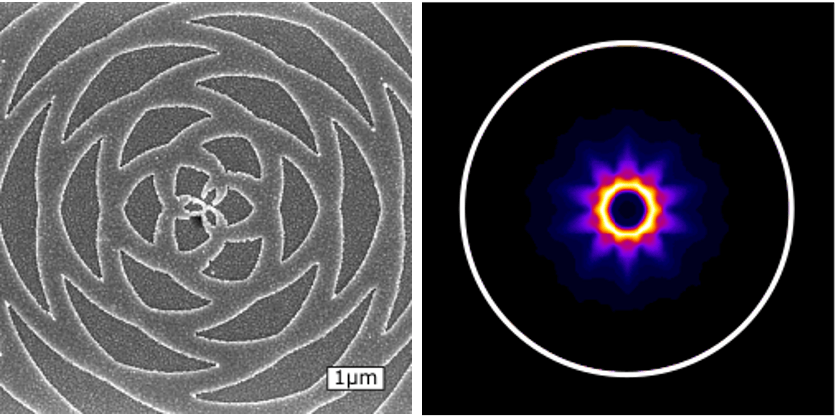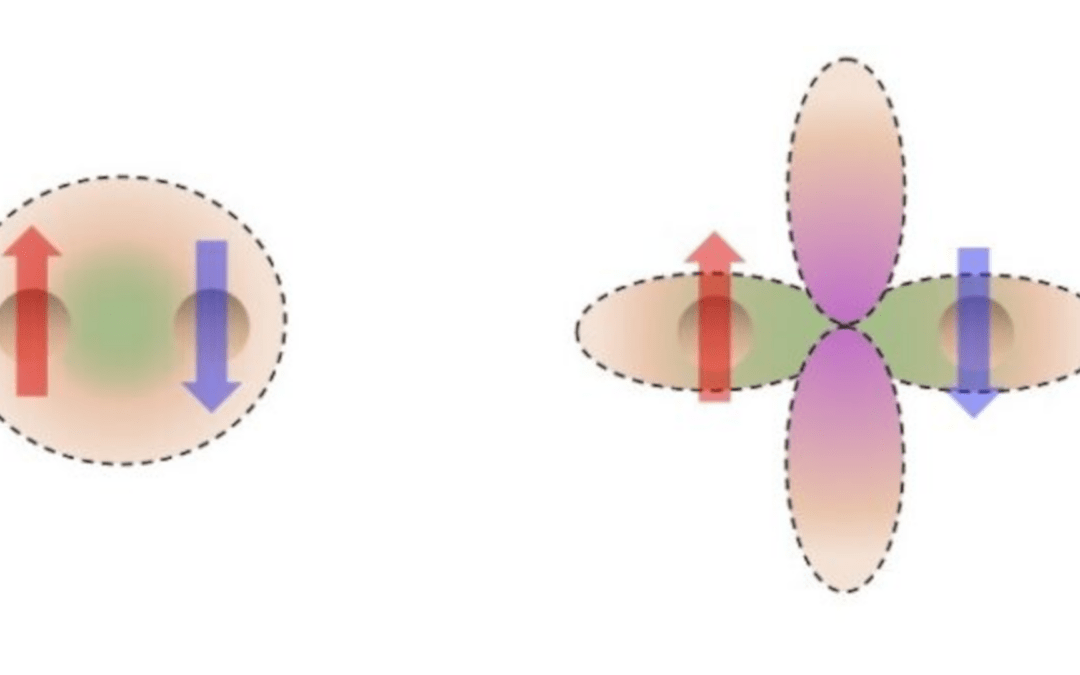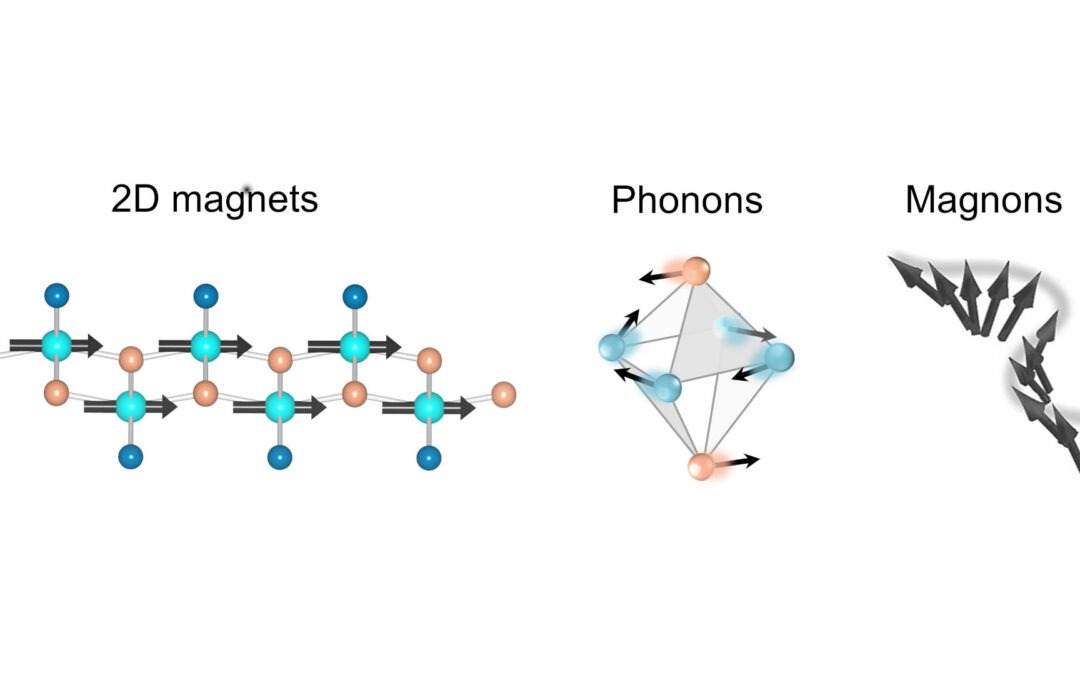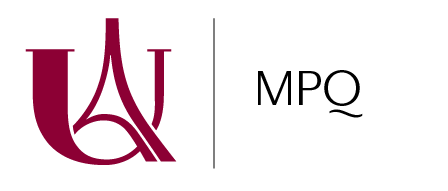
An experimental meta-surface to generate intefering vortices (left) and the resulting light beam when hybridized with luminescent nano-crystals (right) [1].
Laboratoire: MPQ (Matériaux et Phénomènes Quantiques), Université Paris Cité & CNRS
Adresse: Bâtiment Condorcet – 10 Rue A. Domon et L. Duquet – 75013 Paris
Directeur de stage/thèse: Aloyse Degiron
Tel: 0157276226
e-mail: aloyse.degiron [at] u-paris.fr
Scientific project:
The past few years have witnessed impressive developments in optical sources capable of emitting light with non-trivial phase and/or polarization patterns, such as optical vortices, vector beams or Airy beams. These structured beams are of interest in many scientific fields ranging from sub-diffraction imaging techniques (Nobel Prize 2014) to optical tweezers (Nobel Prize in 2018). Because structured beams are carved by carefully tailored interferences, their construction requires light possessing a high degree of coherence—typically light produced by a laser.
One research direction pursued by our team is to achieve the same feat with sources of non-lasing light. Non-lasing light (e.g. light from the sun, from LEDs, from burning candles…) lacks of the coherence properties of lasers, meaning that it is not in principle possible to shape all the emitted photons into a single beam—let alone a complex beam such as an optical vortex in which light spirals around a central phase singularity. Our strategy to overcome this fundamental limit is to hybridize a luminescent medium (made of colloidal nanocrystals) with a structured pattern (i.e. a “metasurface”). Rather than emitting random photons in free space, the luminescent medium will emit light with properties dictated by the metasurface. We have already validated these ideas for optical vortices and beams with azimutal polarization [1,2]. The goal of this internship is to generalize these results to vortex knots and vortex links, which are beams with dark phase singularities that form non-trivial topologies such as interlaced or knotted loops [3,4]. The work will include calculations, cleanroom fabrication and optical characterization, with the help of a PhD student of the team.
.
[1] D. Schanne, S. Suffit, P. Filloux, E. Lhuillier, and A. Degiron, Phys. Rev. Appl. 14, 064077 (2020).
[2] A. Caillas, S. Suffit, P. Filloux, E. Lhuillier, and A. Degiron, Nano Lett. 22, 2155 (2022).
[3] J. Leach, M.R. Dennis, J. Courtial, M.J. Padgett, Nature 432, 165 (2004).
[4] M.R. Dennis, R.P. King, B. Jack, K. O’Holleran, M.J. Padgett, Nature Phys. 6 (2010).
Methods and techniques: Singular light, knot theory, nano-optics
Possibility to go on with a PhD: YES
Envisaged fellowship: EU funding, ANR (pending funding), Doctoral school
À lire aussi

TUPHO, pour la production à grande échelle de circuits photoniques intégrés
Le projet TUPHO est une initiative qui veut combler le fossé entre innovation en amont et production à grande échelle dans l’industrie des circuits photoniques intégrés (PICs). Il est porté par Hamidreza Neshasteh et Ivan Favero, membres de l’équipe Light and...

Manipulating unconventional superconducting states via anisotropic strain
Laboratoire: MPQ (Matériaux et Phénomènes Quantiques), Université Paris Cité & CNRSAdress: Bâtiment Condorcet – 10 Rue A. Domon et L. Duquet – 75013 ParisInternship/PhD supervisor: Yann GallaisTel: 0157276989e-mail: yann.gallais@u-paris.fr Scientific project:...

Towards light control of van der Waals magnets
Laboratoire: MPQ (Matériaux et Phénomènes Quantiques), Université Paris Cité & CNRS Adress: Bâtiment Condorcet – 10 Rue A. Domon et L. Duquet – 75013 Paris Internship/PhD supervisor: Niloufar Nilforoushan and Yann Gallais Tel: 0157276223 e-mail:...

Séminaires
Prof. Sebastian Loth — University of Stuttgart, Institute for Functional Matter and Quantum TechnologiesTitle: Coming soon16 Janvier 2026 à 11h00 — Salle Luc Valentin (454A) Dr. Florian Dirnberger — Department of Physics, TUM School of Natural Sciences, Technical...
